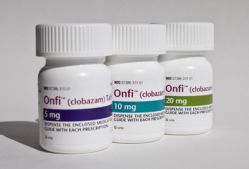Top Class Actions’s website and social media posts use affiliate links. If you make a purchase using such links, we may receive a commission, but it will not result in any additional charges to you. Please review our Affiliate Link Disclosure for more information.

What is Onfi?
Onfi, also sold as clobazam, is an anticonvulsant drug that helps treat seizures. The FDA has approved Onfi to treat several types of epilepsy and other seizure disorders. Like many drugs that act on the brain, it has been discovered that Onfi may also help treat psychiatric disorders. It is not uncommon for researchers to discover that an antipsychotic or antidepressant can treat seizures or vice versa. The FDA has approved Onfi to treat anxiety and psychotic episodes in the short term.
What is Stevens Johnson Syndrome?
Stevens Johnson Syndrome (SJS) is an autoimmune disease caused by an allergic reaction to medications like Onfi. The Onfi SJS reaction starts with flu-like symptoms which escalate to a blistering rash with sores and ulcers. The damage can spread to the surface of the internal organs, and can cause fluid to build up in the lungs. Additionally, the rash can spread to the eyes, causing enough damage to permanently blind the patient. In many cases, Stevens Johnson Syndrome is rare enough that physicians initially mistake it for more common illnesses, like the flu, chicken pox, or other viral infections in the earlier stages of the reaction. This can complicate treatment.
The most severe cases of Stevens Johnson Syndrome can escalate to a more severe form of the reaction called Toxic Epidermal Necrolysis. Patients with Toxic Epidermal Necrolysis experience widespread die-offs of patches of skin. This causes skin to slough off, leaving burn-like wounds all over the body. The damage from Toxic Epidermal Necrolysis so closely resembles burns that ICUs often treat patients with Toxic Epidermal Necrolysis in their burn wards. The exact mortality rate of Toxic Epidermal Necrolysis varies since there is some difference in defining the “cutoff” between Stevens Johnson Syndrome and Toxic Epidermal Necrolysis, but it is estimated to range from 30-50 percent depending on severity, a higher mortality rate than some strains of the Ebola virus. Survivors of Toxic Epidermal Necrolysis and Stevens Johnson Syndrome may face a lifetime of Stevens Johnson Syndrome complications like scarring and blindness.
Both Stevens Johnson Syndrome and Toxic Epidermal Necrolysis are rare enough that medical science has struggled to study them. As such, many questions remain about these reactions. However, it is known that the majority of cases can be linked to various prescription drugs, including a number of seizure medications like Onfi. It is unknown why some patients develop Stevens Johnson Syndrome from drugs like Onfi, but it appears that genetics may play a role. Rare alleles of certain genes related to the immune system occur more often in patients who develop Stevens Johnson Syndrome from Onfi than the general public, but many people with these same genes take Onfi without incident and many people who develop Stevens Johnson Syndrome from Onfi do not have the alleles in question.
FDA Warns About Onfi SJS
The FDA has received reports that rare but life-threatening reactions to the drug, including Stevens Johnson Syndrome and its more severe form, Toxic Epidermal Necrolysis (TEN). As such, the FDA issued a warning that patients taking Onfi immediately seek medical attention if they experience a skin rash, blistering of the skin, and hives. Every report of Onfi SJS or Toxic Epidermal Necrolysis received by the FDA resulted in hospitalization. One case also caused permanent blindness, and one fatality was reported.
Do YOU have a legal claim? Fill out the form on this page now for a free, immediate, and confidential case evaluation. The Stevens Johnson Syndrome attorneys who work with Top Class Actions will contact you if you qualify to let you know if an individual lawsuit or class action lawsuit is best for you. [In general, SJS lawsuits are filed individually by each plaintiff and are not class actions.] Hurry — statutes of limitations may apply.
ATTORNEY ADVERTISING
Top Class Actions is a Proud Member of the American Bar Association
LEGAL INFORMATION IS NOT LEGAL ADVICE
Top Class Actions Legal Statement
©2008 – 2024 Top Class Actions® LLC
Various Trademarks held by their respective owners
This website is not intended for viewing or usage by European Union citizens.
Get Help – It’s Free
Help for Victims of Onfi Stevens Johnson Syndrome
If you or a loved one were diagnosed with Stevens Johnson Syndrome (SJS) or toxic epidermal necrolysis (TEN) after taking Onfi, you may be eligible to take legal action against the drug’s manufacturer. Filing an Onfi SJS lawsuit or Onfi class action lawsuit may help you obtain compensation for medical bills, pain and suffering, and other damages. Obtain a free and confidential review of your case by filling out the form below.
An attorney will contact you if you qualify to discuss the details of your potential case at no charge to you.
Oops! We could not locate your form.












